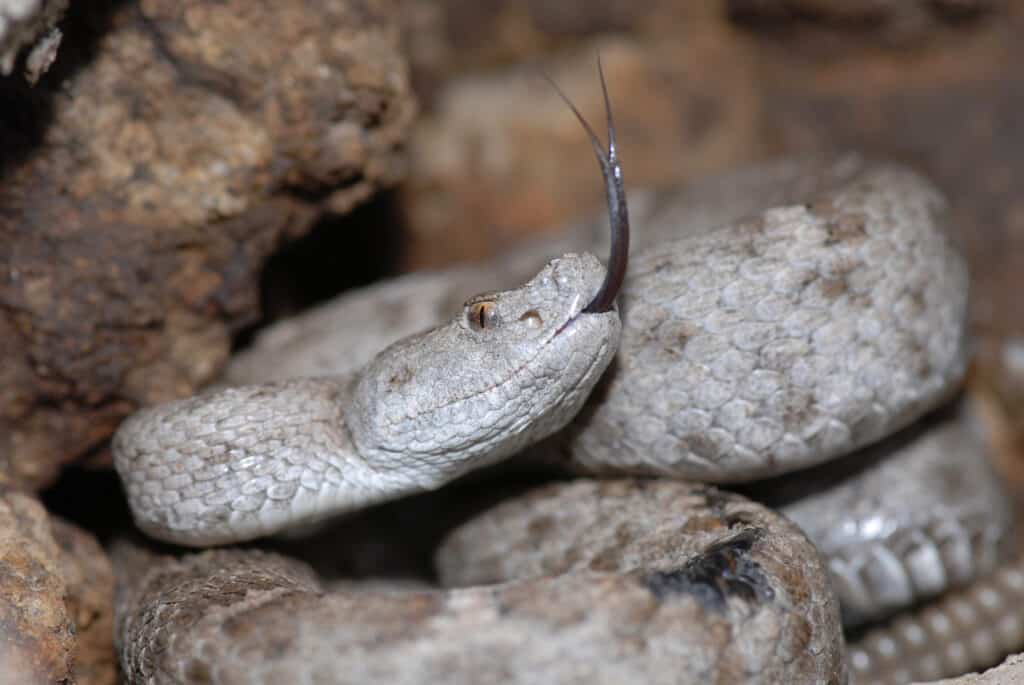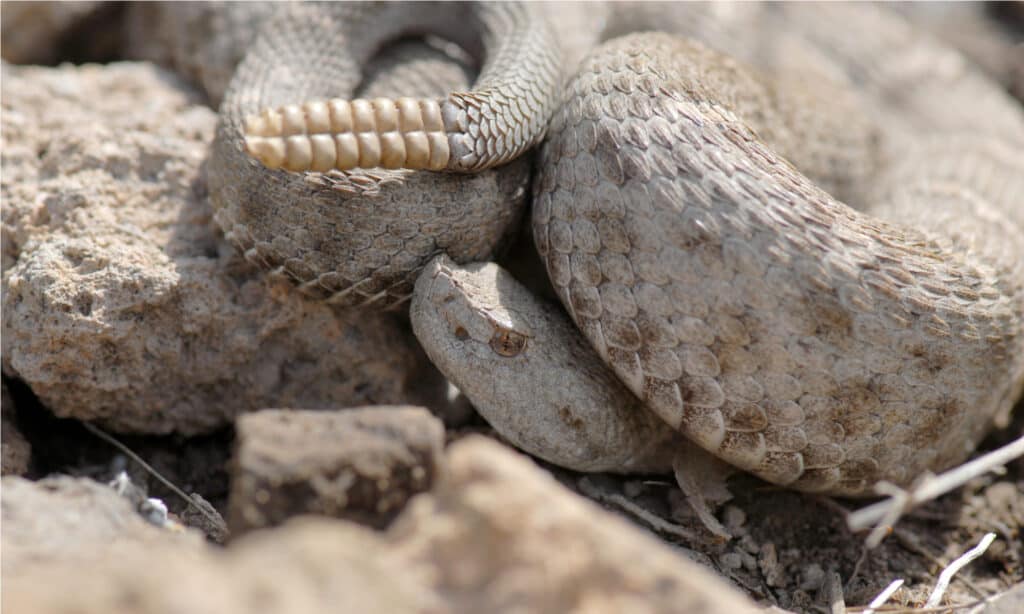Key Points:
- The ridge-nosed rattlesnake is the most recent species of rattlesnake discovered in the United States. It was first described in 1905 and includes five subspecies.
- Pit vipers, like the ridge-nosed rattlesnake, have a heat-sensing pit organ. Pit vipers, or pit adders, include lanceheads, rattlesnakes, and Asian pit vipers.
- The maximum known length a ridge-nosed rattlesnake can attain is about 1.9 to 2.1 feet.
Deserts, mountains, and plains throughout the Western Hemisphere are home to a well-known slithering predator: the rattlesnake. There are more than 24 species of this pit viper, whose namesake tail feature is made of bony segments that clack together when vibrated to produce that infamous rattle. This sound is used to warn away potential attackers and confuse prey. A rattlesnake uses a special throat opening called a glottis to emit a loud hissing sound that also indicates its hostility.
The ridge-nosed rattlesnake is the most recent species of rattlesnake discovered in the United States. It was first described in 1905 and includes five subspecies. This rattlesnake is found in the “sky island” regions, which are isolated mountains throughout the southwestern U.S. and Mexico. Even though it’s a relatively small snake, as you’ll see below, it’s worthwhile to wonder which is the largest specimen ever recorded.

What Are Ridge-Nosed Rattlesnakes?

Ridge-nosed rattlesnakes are also known as Willard’s rattlers or Willard’s rattlesnakes.
©Matt Jeppson/Shutterstock.com
The ridge-nosed rattlesnake’s scientific name is Crotalus willardi. It is a species of venomous pit vipers, a subfamily of venomous vipers called Crotalinae that live in Eurasia and the Americas. They have a heat-sensing pit organ, hence their name. Pit vipers, or pit adders, include lanceheads, rattlesnakes, and Asian pit vipers.
Ridge-nosed rattlesnakes are also called Willard’s rattlers or Willard’s rattlesnakes. The Crotalus willardi species is categorized into five subspecies:
- Crotalus willardi amabilis: Del Nido ridge-nosed rattlesnake that lives in Mexico, in north-central Chihuahua
- Crotalus willardi meridionalis: Southern ridge-nosed rattlesnake that lives in Mexico, in southwestern Zacatecas, and in southern Durango
- Crotalus willardi obscurus: New Mexico ridge-nosed rattlesnake that lives in southeastern Arizona and southwestern New Mexico, as well as in northwestern Chihuahua and northeastern Sonora
- Crotalus willardi silus: Chihuahuan ridge-nosed rattlesnake that lives in eastern Sonora and in western Chihuahua
- Crotalus willardi willardi: Arizona ridge-nosed rattlesnake living in northern Sonora and southeastern Arizona.
Ridge-Nosed Rattlesnake Habitat, Appearance, and Diet
Ridge-nosed rattlesnakes are small snakes measuring approximately 1-2 feet long (30-60 cm). The average size of the species is about 18 inches (45 cm). These snakes are usually dark brown with white horizontal stripes. They get their name from the unique ridges on each side of their noses. Also, they live in 5,500 to 9,000-foot-high habitats, such as pine woodlands in mountain canyons.
Willard’s rattlers feed on birds, lizards, small mammals, and large centipedes. In general, pit vipers are excellent hunters. They are considered ambush hunters, which means they wait for the prey to approach and then catch it.
The life expectancy of a ridge-nosed rattlesnake is approximately 21 years.
Are Ridge-Nosed Rattlesnakes Venomous?

Ridge-nosed rattlesnakes are mildly venomous.
©iStock.com/Shoemcfly
Yes, ridge-nosed rattlesnakes are venomous, but their hemotoxic venom is not as dangerous to humans as it is to other animals. Compared to other rattlesnakes, the venom of Crotalus willardi is milder.
Even though there aren’t any official ridge-nosed rattlesnake bite-related deaths, the wound may hurt if you get bitten. It can also cause some discomfort. We recommend checking with a doctor anyway to make sure everything’s fine.
What Is the Largest Ridge-Nosed Rattlesnake Ever Recorded?

Ridge-nosed rattlesnakes that reach 2 feet are rare.
©Rusty Dodson/Shutterstock.com
The maximum length a ridge-nosed rattlesnake can attain is about 1.9 to 2.1 feet. At the moment, there are no large specimens recorded. Also, some sources suggest that even 2 feet specimens are rare. This is odd for snake species in general.
Most species of snake have at least one specimen known as the largest, breaking the norm regarding the average size. Therefore, it is odd to see a species, albeit relatively new, without the largest recorded individual.
However, if we consider the environment and living conditions of ridge-nosed rattlesnakes, the oddity becomes fully explainable.
As we mentioned, Crotalus willardi live mainly in the sky island regions. These regions are isolated and are rarely introduced to new predators, types of food, and so on. As such, the ridge-nosed rattlesnake didn’t have the chance to experience diet or temperature changes that would cause abnormal growth. This is one of the main reasons there are no records of large specimens of ridge-nosed rattlesnakes.
Why Is the Ridge-Nosed Rattlesnake Endangered?
Ridge-nosed rattlesnakes are listed as “Least Concern.” This means that the International Union for Conservation of Nature (IUCN) does not consider this species worth protecting and conserving because these snakes are still numerous.
Four of the five ridge-nosed rattlesnake subspecies are safe, as their vast population remains. Still, the New Mexico ridge-nosed rattlesnake is considered an endangered and threatened subspecies.
There’s still a risk of a population decline, as collectors once exploited the species with the intention of being sold on commercial markets. This was due to the snake’s small size (easy to capture) and distinctive characteristics.
This is another reason why the species couldn’t sustain the growth of a large specimen. Collectors swarmed the habitats of the ridge-nosed rattlesnake and destroyed them, thus limiting the suitable habitat areas for the species.
What Is the Largest Species of Rattlesnake?

The largest eastern diamondback rattlesnake recorded measured 8 feet long.
©Chase D’animulls/Shutterstock.com
The largest rattlesnake species is the eastern diamondback rattlesnake (Crotalus adamanteus). On average, it can grow up to 6 feet (1.8 m); the largest specimen recorded was 8 feet (2.4 m). Crotalus adamanteus is known as the heaviest among venomous snakes in the Americas.
The eastern diamondback is three times larger than our tiny ridge-nosed rattlesnake. Luckily, they live on opposite shores, so a confrontation between the two specimens is unlikely.
Interesting Facts About the Ridge-Nosed Rattlesnake
Since we couldn’t tell you anything impressive related to the size of the species, we decided to include in this article some interesting facts that will certainly make you appreciate this small species of snake even more.
You might even decide to take one as a pet, if possible. Due to their small size, ridge-nosed rattlesnakes are easy to handle.
- The most distinctive characteristic of the species is the prominent ridge on its snout.
- Most subspecies are active foragers, feeding mainly on birds, small mammals, lizards, arthropods, and other snakes.
- As agile climbers, ridge-nosed rattlesnakes can climb into trees and track prey from high above.
- Most subspecies are known for their impressive camouflage. They can blend in quite easily with the forest floor.
- Subspecies can be found in habitats as high as 5,500 (1,675 m) and even 9,000 feet (2,745 m).
- The species has a low reproductive rate, an aspect that increases the chances of extinction if conservation action and agreements are not established.
Other Record-Breaking Snakes
The largest ever recorded eastern brown snake measured 7.9 feet (2.4 m) in length, but this is not a typical size for this species, especially since the measurement comes from a specimen found in the northern populations. Research suggests that the northern populations tend to have bigger snakes than the southern populations.
The western brown snake and the Dugite (also known as the spotted brown snake) are the brown snake species with the second-greatest length. They have the potential to reach a length of 6.5 feet (2 m).
Furthermore, it is not the longest brown snake ever recorded, Gigantor holds the record for the largest brown snake in Australia in terms of both length and weight. Despite only measuring 6.5 feet (2 m) in length, it is recognized as the largest due to its significant weight.
The photo featured at the top of this post is © Matt Jeppson/Shutterstock.com
Discover the "Monster" Snake 5X Bigger than an Anaconda
Every day A-Z Animals sends out some of the most incredible facts in the world from our free newsletter. Want to discover the 10 most beautiful snakes in the world, a "snake island" where you're never more than 3 feet from danger, or a "monster" snake 5X larger than an anaconda? Then sign up right now and you'll start receiving our daily newsletter absolutely free.
Thank you for reading! Have some feedback for us? Contact the AZ Animals editorial team.






